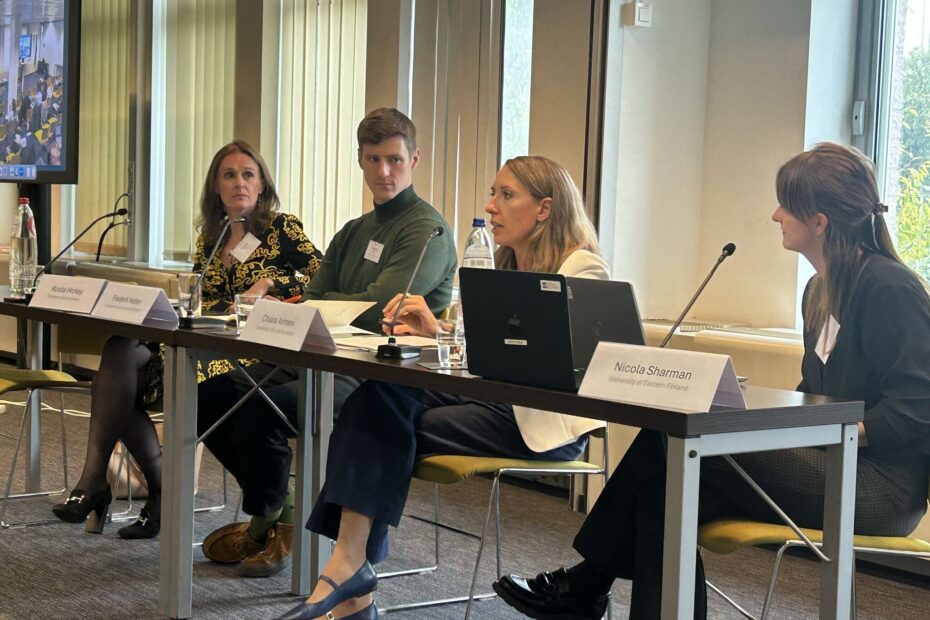Published: 6 November 2025. Written by:
Nicola Sharman, Doctoral Researcher, University of Eastern Finland,
Pielpa Ollikainen, University of Helsinki,
Professor Päivi Leino-Sandberg, University of Helsinki
On 23 September 2025 the 2035Legitimacy project convened a workshop in Brussels to examine the Aarhus Convention and the European Union’s position within it with the 2025 Meeting of the Parties (MOP) approaching in November 2025. Has the EU done enough to ensure sufficient avenues to challenge environmental law violations? How can planning of the ecological transition be accelerated, while ensuring public participation in and acceptability of new projects? Is the European Commission living up to the transparency requirements and aspirations of the Convention? How can the Convention surmount challenges arising from the high workload of its Compliance Committee (ACCC) and the slow implementation of the Committee’s findings? What have been the achievements and challenges of the recently established Rapid Response Mechanism for environmental defenders?
The workshop brought together academics, policymakers, journalists and stakeholders to explore the ongoing trajectory of the Convention under its three pillars of access to information, public participation and access to justice. The key note speech was delivered by Professor Áine Ryall, Chair of the ACCC, who highlighted several significant milestones of EU engagement, but also ongoing challenges including limited resources, changing geopolitical landscape putting multilateralism under threat, and the increasing deregulation agenda, which turn the world into a more hostile place for Aarhus rights.
Access to Information
The panel was chaired by Onno Brouwer (Partner, Freshfields) and included Fred Logue (FP Logue LLP, Ireland), Staffan Dahllöf (Freelance Journalist, Denmark) and Professor Päivi Leino-Sandberg (University of Helsinki) as panelists. The panelists discussed how the Aarhus Convention and EU rules on access to environmental information deliver and fail to deliver.
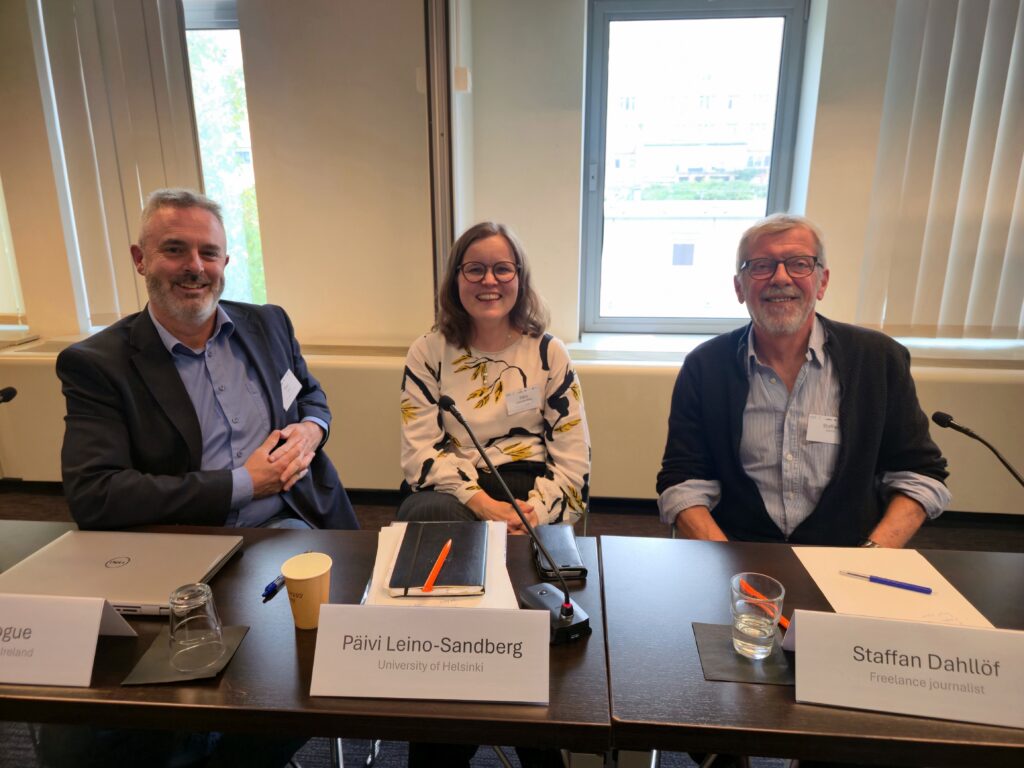
Fred Logue described real-world Irish cases using access to information on the environment (AIE) requests to expose unlawful “emergency” works and force active publication of protected-species licences, often with positive experiences. He also explained his work on a number of pending court references and Aarhus Committee files with a view to using AIE requests and the possible remedies to improve transparency, public participation, access to justice and loosen systemic barriers. These cases target various shortcomings in national legislation, such as active dissemination of information, charges levied for access requests and unlawful formalities.
Staffan Dahllöf recounted his recent experience from appealing to the ACCC, which involved a cross-border reporting project on PFAS – a hazardous pesticide – and his struggle with Swedish national secrecy, based on Sweden’s possibility to participate in international collaboration, which led him to appeal the decision before a national administrative court. Dahllöf recounts more success at the EU agency level, with the European Food Safety Authority disclosing the requested information, and a positive finding from the Aarhus Compliance Committee, which found Sweden had failed to justify its refusal (Case ACCC/C/2019/173) and will lead to a four-year follow-up and 2029 MOP draft-report input.
Päivi Leino-Sandberg explained how EU institutions largely treat the Aarhus Convention as subordinate to Regulation 1049/2001 regarding public access to European Parliament, Council and Commission documents, even when ECJ case law requires EU law to conform with international agreements. This creates problems when the implementation of Regulation 1049/2001 does not live up to the requirements of the Aarhus Convention, for example as regards general presumptions of confidentiality that may also cover environmental information. The Aarhus Regulation has become a prisoner of Regulation 1049/2001. She flagged infringement files as a particular problem and noted that the Aarhus Convention and Aarhus Regulation are seldom applied ex officio to access to documents requests, even when they concern environmental information. In practice, an applicant needs to raise the argument themselves.
In discussion, panelists pressed for better proactive publication, enforcement of MOP-endorsed Committee findings, greater attention given to aspects of “good administration” in the application of environmental rights and the possibilities of strategic litigation before both the EU courts and the ACCC to enforce the right of access to environmental information. Panelists drew attention to the recent NYT v Commission case as a positive development for scrutinizing the Commission’s document retention practices. The panelists agreed that a reform of 1049/2001 creates more risks for further narrowing access, particularly in view of the new Commission Rules of Procedure that seek to limit access even further, contrary to what the Aarhus Convention allows.
Public Participation
The panel was chaired by Nicola Sharman (University of Eastern Finland) and featured Professor Chiara Armeni (Université Libre de Bruxelles), Frederik Hafen (European Environmental Bureau) and Rosita Hickey (European Ombudsman’s office) as panellists. Across the panellists’ interventions and discussions, several cross-cutting themes emerged.
First, the panel discussed the perceived tension between urgency and participation. This has come into sharp focus with the Commission’s recent Omnibus proposals to simplify elements of the European Green Deal, which has been presented as an urgent response to ease administrative burden and declining competitiveness. But the proposals are criticised as a step backwards on environmental policy that offered little opportunity for public participation and is now the subject of an investigation by the European Ombudswoman. Panellists warned that ‘urgency’ risks becoming a pretext to bypass public consultation. As the Ombudswoman recently stressed, institutional agility cannot come at the expense of predictability and legal certainty. Rosita Hickey noted that her findings would contain important lessons for the Commission and other states on when, if ever, urgency can justify limiting participatory rights.
Second, panellists raised concerns about the use of EU legislation that allows accelerated permitting for renewable energy and critical raw materials projects. While intended to advance energy, economic and environmental goals, these EU policies risk emboldening national governments to disregard local communities, as Frederik Hafen noted has been alleged in the controversial case of Portugal’s Barroso Lithium mine. He pointed out that other successful projects, such as strategic wind power development in Burgenland, Austria, support the claim that robust public participation in the early planning stages can in fact aid, rather than delay, swift deployment and public acceptance.
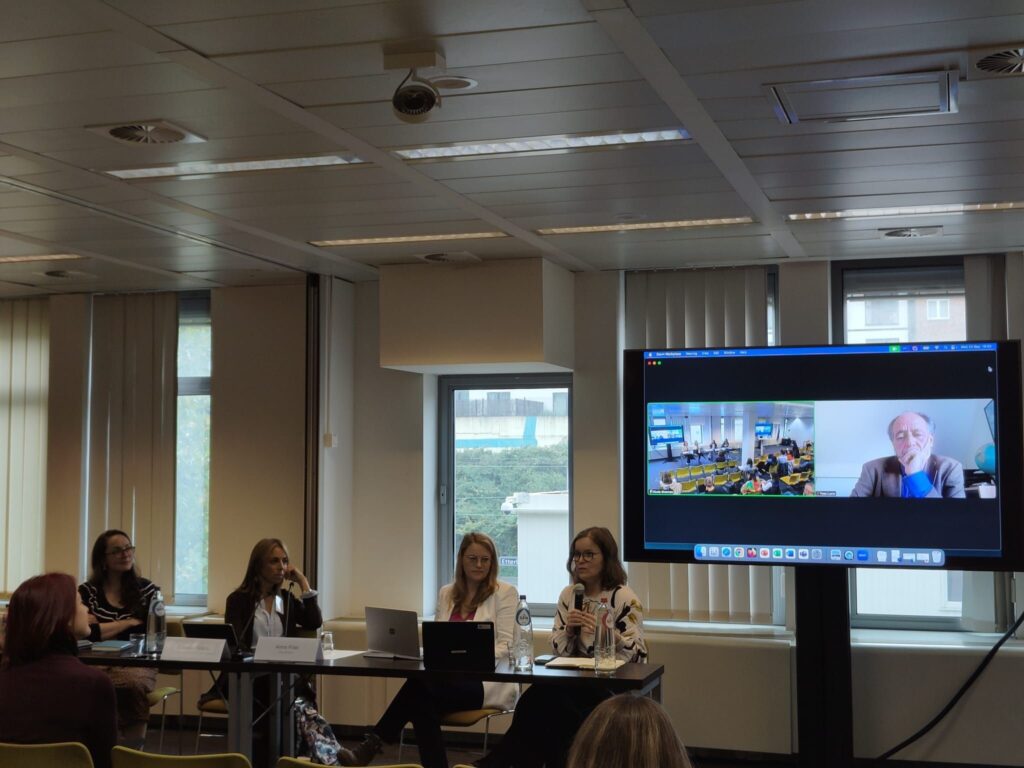
Third, the topic of ‘citizen-washing’ was raised and the risk that stakeholder consultations are tilted towards industry interests. Frederik Hafen, for example, described NGOs being invited to stakeholder roundtables on the Omnibus proposals but denied the floor, which may tick the participation box on paper but excludes genuine dialogue. Meanwhile, crisis-born industry platforms, such as the Energy Platform Industry Advisory Group, risk becoming permanent fixtures shaping general policy without NGO or community voices. The EU and member states must ensure that under-resourced NGOs and vulnerable groups retain a meaningful seat at the table if participation is to counter, rather than echo, corporate power.
Fourth, the panel reflected on the changing realities of participation since the Aarhus Convention’s adoption in 1998. New and innovative participatory formats, such as citizens assemblies and stakeholder forums, have become popularised. Digital tools also offer new opportunities for public notification, communication and engagement, while traditional methods remain relevant for certain audiences and contexts. And yet, the Convention’s Implementation Guidelines have not been updated since 2014. Several speakers thus suggested it may be time to revisit the Guidelines in light of these new realities to clarify expected standards in the modern context.
Fifth, the panel addressed participation of environmental defenders. Chiara Armeni spoke of her research on the wide scope of what it means to participate, including engagement through protest and advocacy. Although Article 3(8) of the Convention protects persons exercising their Aarhus rights against penalisation, persecution or harassment, the Special Rapporteur on Environmental Defenders, Michel Forst, has reported worrying trends in the repression of environmental defenders across Europe through restrictive policing, legal restrictions on protest, and harsh sentencing for civil disobedience. While there may be some positive signals that this issue is being taken seriously, like the recently enacted Anti-SLAPP Directive, these are limited in scope. States must ensure that domestic legal frameworks fully implement Article 3(8).
Access to Justice
The panel was chaired by Professor Annalisa Saravesi (University of Eastern Finland) and featured Professor Mariolina Eliantonio (Maastricht University), Sebastian Bechtel (ClientEarth), and Sofia Heikkonen and Pielpa Ollikainen (University of Helsinki) as panelists. The panelists provided three complimentary perspectives on the issue, arriving at a comprehensive overview of issues in implementing the pillar.
Professor Eliantonio’s intervention was based on a co-authored paper with Justine Richelle which critically examines the judicial and non-judicial mechanisms available for litigating breaches of environmental law in the EU. She provided an outline of the shortcomings of three key means through which the Union purports to provide access to justice through such mechanisms. First, in direct actions for annulment to the Court of Justice of the European Union (CJEU), the Court has adopted an extremely strict interpretation of ‘implementing measures.’ The interpretation has had the effect that no case against a regulatory act has been successful since the Lisbon Treaty. Second, the significance of the CJEU’s preliminary reference procedure has been negligible, as only four cases brought by environmental NGOs have reached the Court. Third, the EU’s internal administrative review procedure was discussed. On the one hand, the Aarhus Regulation reform has been successful in removing barriers to admissibility, shown by a reduction in the inadmissibility rate of review requests from 80% to 33%. The number of requests made has also drastically increased. Nonetheless, none of the requests have been found to be grounded, raising the question whether the review mechanism is sufficiently independent. In summary: ‘direct review is inaccessible, indirect review is cumbersome and potentially also inaccessible, administrative review is toothless.’
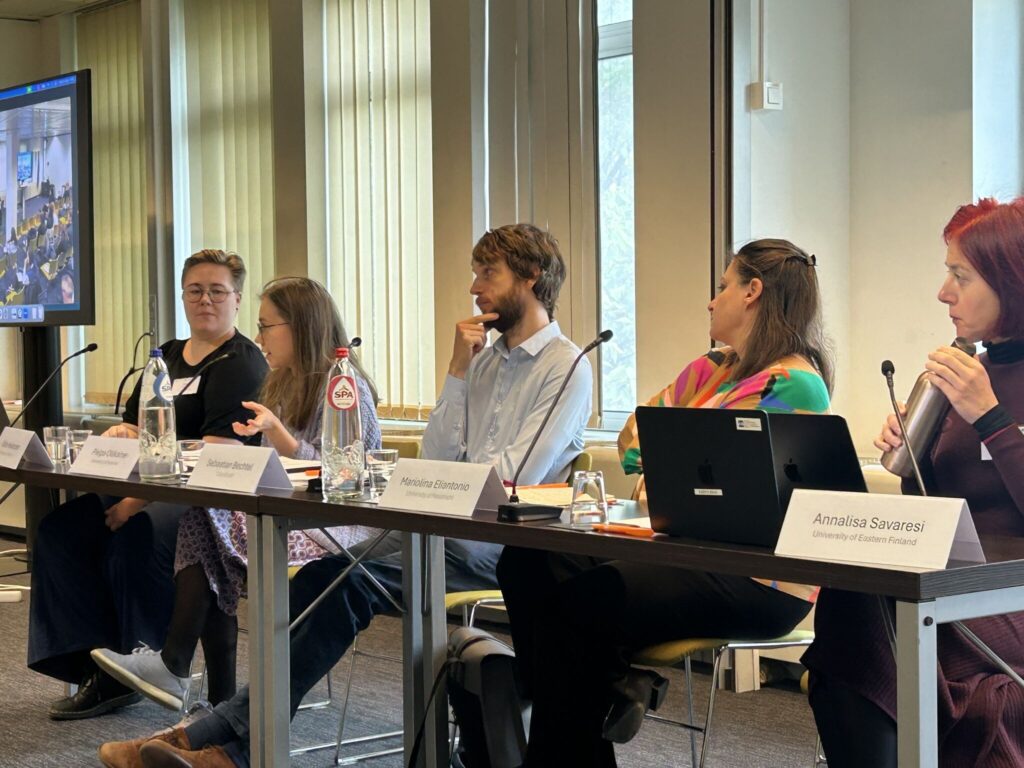
Sebastian Bechtel offered insight from practice, focusing on barriers faced by NGOs on both the EU and Member State level. Non-compliance with environmental law is extremely costly, and environmental NGOs do important work helping the Commission as external enforcers in the EU, work which should be recognized. But barriers that hinder this work are both practical and legal. Practical barriers include access to funding for litigation, accessing legal expertise, and having sufficient civic space. In terms of legal barriers, the reform of the Aarhus Regulation and Article 9(3) access to justice guarantees should be seen as a significant source of optimism, but the intensity and standard of review remain important. A major issue has been the lack of willingness by the General Court to engage with legal questions raised by applicants or the scientific evidence. A potential solution would be higher environmental specialization within courts.
The final intervention by Sofia Heikkonen and Pielpa Ollikainen discussed the way the Convention is interpreted by the CJEU, based on a co-authored forthcoming article which systematically examines the Court’s case-law on application of all three of the Convention’s pillars to EU institutions compared to Member States. The CJEU’s interpretation evidenced a double standard between what is required of the institutions versus Member State authorities that is most striking in the access to justice context, but which extends to the two other pillars of the Convention. The Convention was consistently interpreted by the Court in an expansive way in relation to Member States’ obligations but sidelined or interpreted restrictively in cases brought against the EU institutions. The panel noted the apparent hypocrisy exposed by the findings and considered them in light of the non-compliance finding of the ACCC against the EU with regards to the Court’s appeal admissibility tests, and the EU’s reluctance to implement those findings. It partially explains the EU’s position given the challenge it appears to pose to the Court’s gatekeeper role with regard to international law.
Outlook
The panel was chaired by Anne Friel (ClientEarth) and included Claudia Fusco (Director, DG ENV.E, European Commission), Professor Emily Barritt (Dauphine Université Paris, PSL) and Yves Lador (Earthjustice Representation to the UN in Geneva) as panellists.
It was a recurring theme throughout the discussion on which all panellists agreed that much of the Convention’s strength lies in its capacity to evolve as a living instrument. The Aarhus Convention was negotiated during a different environmental and political era, yet its principles have never been more relevant. All actors have a role to play in cooperating to meet new challenges and to keep using, testing and pushing the Convention’s limits to ensure a positive trajectory and prevent regression.
In this spirit, the Aarhus Convention must be interpreted to respond to the realities of global problems and planetary crisis. As Emily Barritt underlined in her intervention, this was distinctly illustrated in the European Court of Human Rights’ (ECtHR) landmark Klimaseniorinnen judgment, where the Court took significant inspiration from the Convention to expand its traditional test of victim status beyond a restriction to individuals by granting a right of standing to an association. This was a significant shift in approach, and we can hope that it may inspire other courts. Yet Emily Barritt also raised concerns that the ECtHR in this case distinguished climate change from more linear and localised environmental problems. This restrictive interpretation risks overlooking the breadth of the Convention’s core objective, stated in its opening article, to protect ‘the right to every person of present and future generations to live in an environment adequate to his or her human health and well-being’.
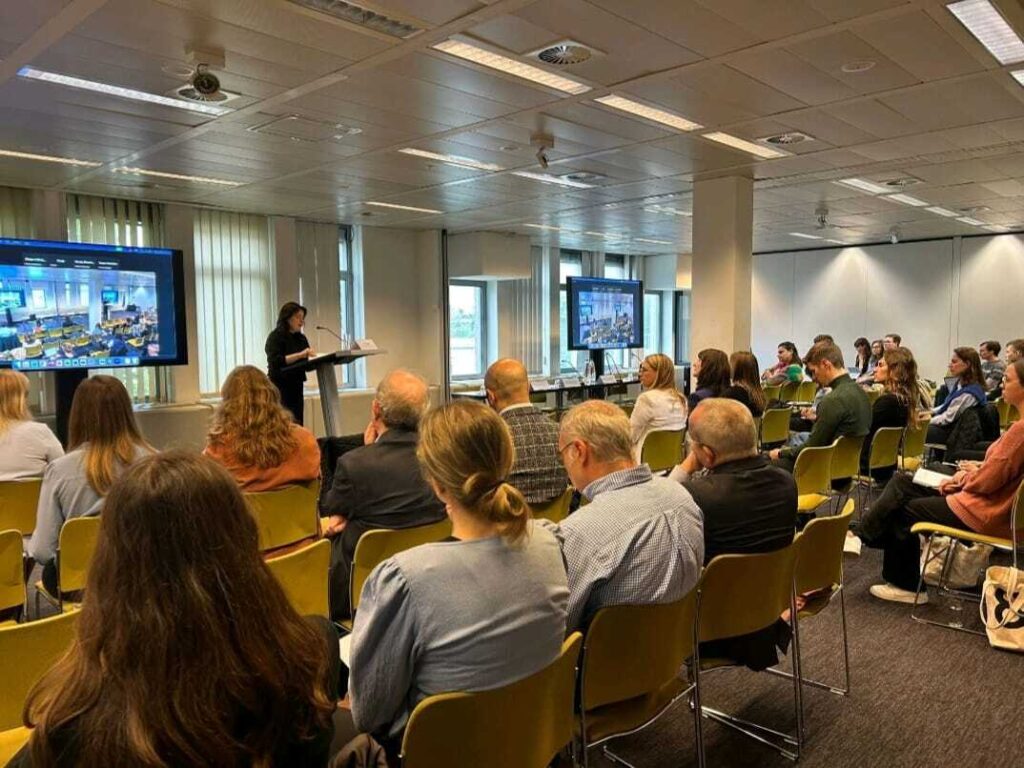
As stressed by Yves Lador in his intervention, the establishment of the role of the Special Rapporteur for Environmental Defenders and the development of the Rapid Response Mechanism in 2021 strongly illustrates the Convention’s adaptive capacity. This was a reform that was born from crisis, after former Aarhus member Belarus dismantled an NGO that brought a complaint against it. The reports of the Special Rapporteur and other organisations of the growing repression of and hostility towards environmental defenders worldwide underlines the criticality of his work. The RRM has been well used, with around 95 complaints received since its establishment (75 of which were deemed to be admissible) and even one case described as ‘lifesaving’. A lot has therefore been accomplished and there will be value in continuing to also translate the Special Rapporteur’s work into sustained and systematic protections, through development of Guidelines, referrals to the Compliance Committee, and using his work to support outreach beyond the Aarhus jurisdiction.
Claudia Fusco, on behalf of DG Environment at the EU Commission, provided some optimism by affirming the EU’s commitment to uphold Aarhus values. She pointed to several examples of legislative progress such as the amended Aarhus Regulation and laws on air quality, wastewater, and renewable energy, policy initiatives such as the forthcoming Civil Society Strategy. National implementation remains uneven, and the Commission has an important role in monitoring and enforcement. But the representative also stressed the broader geopolitical context of simultaneously needing to protect the EU economy, competitiveness and resources. While recognising the importance of these pressures, other contributors cautioned that economic resilience should not, and does not have to, come at the expense of Aarhus’s democratic principles. Rather, participation should not be viewed as an obstacle, but as a cornerstone of democracy, effective governance, the rule of law and the substantive right to a healthy environment.
